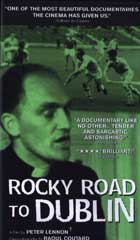
Rocky Road to Dublin 1967
Distributed by First Run/Icarus Films, 32 Court St., 21st Floor, Brooklyn, NY 11201; 800-876-1710
Produced by Peter Lennon
Directed by Peter Lennon
VHS, color, 69 min.
Sr. High - Adult
European Studies, Film Studies, History, Political Science, Religious Studies, Ireland
Date Entered: 02/01/2006
Reviewed by Jane Sloan, Rutgers University LibrariesThese two films present documentation of an important, very particular time and ideology. Peter Lennon, an Irish journalist who had worked for years in Paris returned to his native land in the mid 1960s and wrote a series of articles about the repressed nature of the Irish people and their total domination by the Catholic Church. He attributed their circumstances to a reactionary church organized to fill the power vacuum created by revolutionary upheaval that began with the Easter uprising of 1916 and ended with political independence for southern Ireland from England in the early 1920s. He turned these observations, which comprise a meditation on the question “What do you do with your revolution now that you’ve got it?” into a documentary film with the assistance of the famed French cinematographer Raoul Coutard.
Both men had a deep sense of history and power relations that inflects the film with striking complexity and strong feeling. Interviews with Irish intelligentsia contribute to a perspective that can only be described as thoroughly thoughtful, sensitive, and attentive to the ironies and reality of people used to being intimidated and seeking diversion in music, dance, and alcohol. Their relationship to the Church is deemed “not a villainous conspiracy, just a bad habit.”
Conor Cruise O’Brien bemoans the Irish government’s alignment with U.S. foreign policy, asserting that “once people get scared, they tend to stay scared.” A ban on “foreign games” is defended by an official as necessary to promote “Irish manhood.” The director of the Abbey Theater insists the “old guard” must be removed as bells toll through a list of banned authors and a censor sincerely wonders about his society’s “affection for evil.” John Huston, there to make an American film on location, is adamant that all the money coming into Ireland because of his production is not half as important as a native film made by Irish people. Sean O’Faolain disparages “urbanized peasants” prone to “self-interested silence.” In between these uniformly pithy and expertly obtained pronouncements, we are treated to lengthier audio and visual arias of a spoon player entertaining bar patrons, a teenage icebreaker dance, a priest singing “Chattanooga Choo Choo,” and children gleefully running after the camera mounted on a car.
The accompanying 2004 videotape The Making of Rocky Road to Dublin is more accurately a description of the film’s reception. Coldly treated in Ireland, it was accepted for Critics Week at Cannes in 1968 and was the last film shown before Jean-Luc Godard and Francois Truffaut insisted the festival be closed down. The film has footage of their public encounter with Lennon and documents the second life the film had as a favorite of dissenting students in France. It contains interviews with Lennon and Coutard, who describes Lennon as a person of “great professional conscience.” The film later gained notoriety when it was revealed that the singing priest, who wistfully states that he would “like to be married,” had already had a child with his housekeeper.
Rocky Road to Dublin is a special film primarily about Ireland, but reflective of the breadth and depth of international socialist consciousness of the time. Highly recommended for all types of libraries.